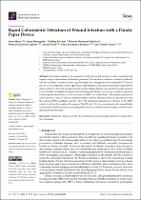| dc.contributor | Consorci Sanitari de Terrassa |
| dc.contributor.author | Hoyo, Javier |
| dc.contributor.author | Bassegoda, Arnau |
| dc.contributor.author | Ferreres Cabanes, Guillem |
| dc.contributor.author | Hinojosa-Caballero, Dolores |
| dc.contributor.author | Gutiérrez-Capitán, Manuel |
| dc.contributor.author | Baldi, Antonio |
| dc.date.accessioned | 2023-05-22T11:16:06Z |
| dc.date.available | 2023-05-22T11:16:06Z |
| dc.date.issued | 2022-08-15 |
| dc.identifier.citation | Hoyo J, Bassegoda A, Ferreres G, Hinojosa-Caballero D, Gutiérrez-Capitán M, Baldi A, et al. Rapid Colorimetric Detection of Wound Infection with a Fluidic Paper Device. Int J Mol Sci. 2022 Aug 15;23(16):9129. |
| dc.identifier.uri | https://hdl.handle.net/11351/9583 |
| dc.description | Heridas crónicas; Biomarcador de infección; Mieloperoxidasa; Colorimetría |
| dc.language.iso | eng |
| dc.publisher | MDPI |
| dc.relation.ispartofseries | International Journal of Molecular Sciences;23(16) |
| dc.rights | Attribution 4.0 International |
| dc.rights.uri | http://creativecommons.org/licenses/by/4.0/ |
| dc.source | Scientia |
| dc.subject | Peroxidasa |
| dc.subject | Ferides i lesions |
| dc.subject | Biomarcadors |
| dc.subject | Colorimetria |
| dc.subject.mesh | Peroxidase |
| dc.subject.mesh | Wounds and Injuries |
| dc.subject.mesh | Biomarkers |
| dc.subject.mesh | Colorimetry |
| dc.title | Rapid Colorimetric Detection of Wound Infection with a Fluidic Paper Device |
| dc.type | info:eu-repo/semantics/article |
| dc.identifier.doi | 10.3390/ijms23169129 |
| dc.subject.decs | peroxidasa |
| dc.subject.decs | heridas y lesiones |
| dc.subject.decs | biomarcadores |
| dc.subject.decs | colorimetría |
| dc.relation.publishversion | https://doi.org/10.3390/ijms23169129 |
| dc.type.version | info:eu-repo/semantics/publishedVersion |
| dc.audience | Professionals |
| dc.event.productor | Biblioteca |
| dc.contributor.authoraffiliation | [Hoyo J, Bassegoda A, Ferreres G] Grup de Biotecnologia Molecular i Industrial, Departament d'Enginyeria Química, Universitat Politècnica de Catalunya, Terrassa, Spain. [Hinojosa-Caballero D] Unitat de Ferides Complexes, Consorci Sanitari de Terrassa, Hospital de Terrassa, Terrassa, Spain. [Gutiérrez-Capitán M, Baldi A] Instituto de Microelectrónica de Barcelona (IMB-CNM), CSIC, Campus UAB, Bellaterra, Spain |
| dc.identifier.pmid | 36012396 |
| dc.rights.accessrights | info:eu-repo/semantics/openAccess |

 Área privada
Área privada Contacto
Contacto







